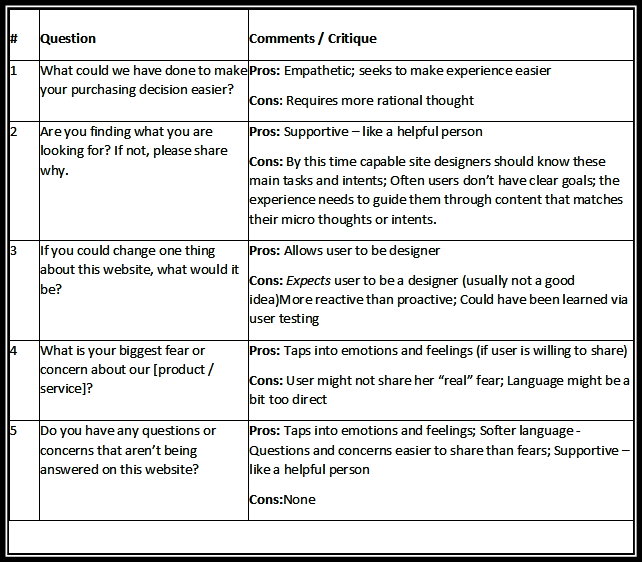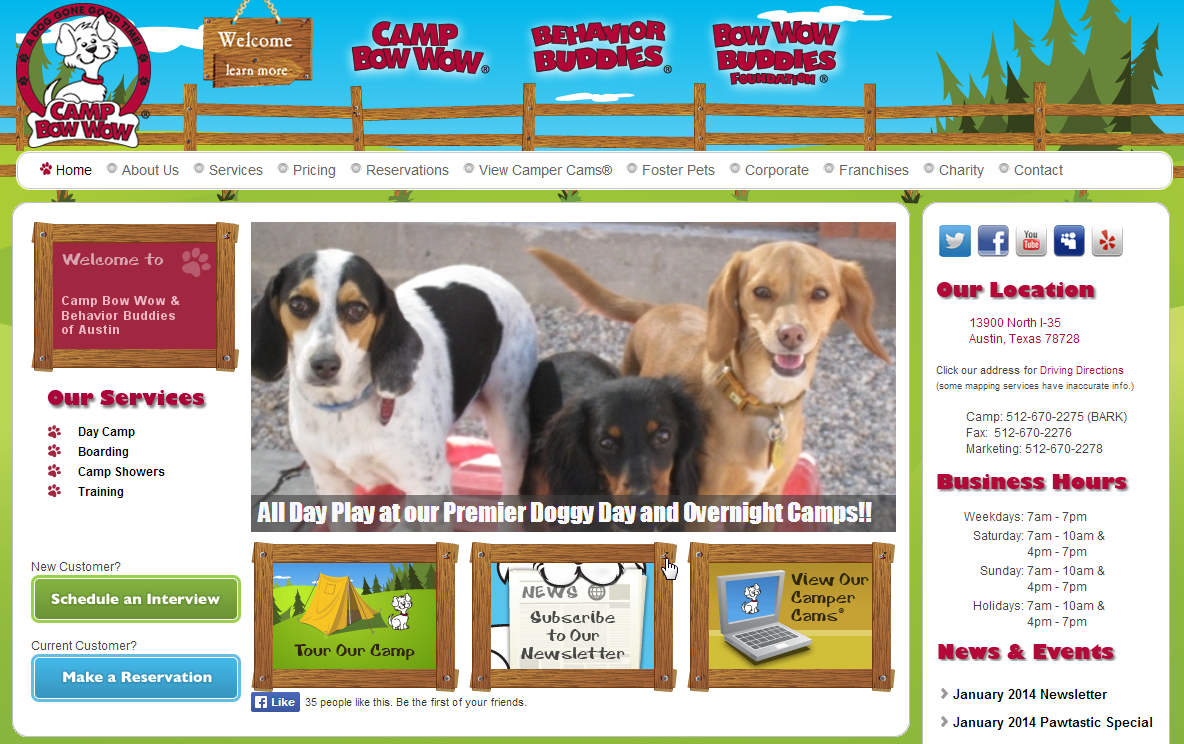Brian Massey posed a great question to me the other day: If you could ask your site visitors only one question, what should it be? I love this question because it distills pre-conversion user research down to its essence: how can you best glean the “why” motivations behind what your users are thinking – and, equally importantly, the concerns they may be feeling – early in their experience? And how can you choose a question that, after you analyze user responses, will be actionable – will allow you to confidently make and test design updates that better address these concerns and improve your conversions?
In this article I’ll focus on what question to ask, and in a future article I’ll unpack where and how you should ask this question.
Start with the research end in mind
Start with the insights goal you’re trying to achieve by asking the question. Are you trying to expose the general concerns or questions (what marketers call “objections”) your visitors may have, or are you more interested in learning something more specific, such as whether your Product Detail page is missing any key information? If you’re new to user experience research, or your website hasn’t undergone any significant usability testing, you should typically start with the “general” goal and ask more open-ended questions.
In this article I’ll assume that you are asking the question of a person who doesn’t yet know and trust your brand and is early in her shopping experience (e.g. just arrived on your website or landing page). A different question – or set of questions – would apply for your converted customers.
First, avoid asking the wrong questions
First, let’s talk about questions you shouldn’t ask. The prospect is already on your site, so clearly your marketing has worked (at least partially). So early in the experience you should avoid asking marketing questions like:
- How did you first hear about us?
- What prompted you to start looking for this type of service?
- What other competitors are you considering?
Instead, focus on the questions most tied to your research goals, and that uncover questions and concerns that would negatively affect your visitor engagement and conversion. Save the marketing questions for further down your sales funnel – for example, on order confirmation pages, in your social media channels, or on your email response pages.
Some possible questions
OK, let’s finally get to the question you should ask. Based on my experience leading research projects for six Fortune 500 clients, and my recent survey of the latest user feedback solicitation tools, here are my top 5 possible questions (in no particular order), along with some pros and cons for each:

Drumroll, please…
In my opinion, the #1 question I would ask is Question #5. Coming in a “Close 2nd” is Question #4.
The two questions are really variations on the same theme. By asking either of them you are communicating, “I value you as a potential customer and am truly interested in learning where our website is missing the mark relative to your needs, wants and expectations. This question is specifically not calling attention to your offer, it’s not “going for the close”, and it’s not asking your visitors to be designers; it’s simply saying “we care, we want to improve your experience, and we’re listening.”
A key thing to remember: for many shopping scenarios, “making a positive brand impression” or “building brand memory” is as important as closing a sale or generating a lead. Connect with the visitor first; sell to her later. Another thing to bear in mind: with the rapid growth of mobile devices usage, prospect experiences are often multi-touch: the prospect hits your website on their iPad the evening of Day 1, briefly visits your site during lunch on Day 2, and again visits your site during an afternoon coffee break on Day 2. So, except in some small dollar amount, single widget sales cases, it’s not a “once and done” interaction (or if it is, it shouldn’t be).
A sample scenario
Let’s say that Judy, a middle-aged woman from Austin, is shopping for a place to board her dog Max while she’s on vacation. She’s willing to pay extra for a better facility and service. After doing a web search for “dog boarders austin,” she lands on www.campbowwow.com.

Judy’s main concerns are:
- Pricing – how much will it cost for the week?
- How much play time her dog will get
- How clean the kennel is kept
Judy sees that these questions are not answered on the top half of the home page. After about 10 seconds of scanning, she’s a bit disappointed and clicks her browser’s Back button. End of experience – for now and perhaps forever.
If our “one question” were asked, she’d have the choice (and who doesn’t like choices?!) to express her questions and concerns. Even if Judy decides to go with another dog boarder this time, there’s a decent chance that a thought like, “Ah yes… Camp Bow Wow… they were the ones who asked for my input,” will get lodged in her longer-term memory. If she were not completely satisfied with the other boarder’s services or staff, a couple weeks before her next trip she might just give Camp Bow Wow a call.
Summing up
Whether or not you consider your organization “customer centric”, you need to start a dialog with your prospects. And the sooner you can do this, the better (both in the experience, and on your website release roadmap). By doing so you’ll discover expectations that your site is not meeting so that you can better address them through user experience and copy updates, and thereby grow your bottom line.
About the Author
Mark is the Owner and Research Director at Hallmark Experience, an agency that focuses on voice of prospect research, usability testing and expert design reviews. He’s had the privilege to work with top brands like Macys, Kaiser Permanente, American Express and AutoZone, as well as smaller, fast-growing companies in the San Diego area. You can reach him here.







 Always pushing his own limits,Mike Tyler, has a track record for success in both business and in the creative worlds. He found his inspiration to battle for what he believes in on a trip around the world. His dedication to perfection, professionalism and focus have helped put Mike on the map as a rising force. Traveling around the world following the surf and living like the locals can do wonderful things to a person. For Mike the people and places rekindled a passion that brought him back to Vancouver. Mike’s focus is people, with a peerlessly sharp eye for detail, Mike Tyler brings a personal touch to his client’s work. You can connect with Mike on
Always pushing his own limits,Mike Tyler, has a track record for success in both business and in the creative worlds. He found his inspiration to battle for what he believes in on a trip around the world. His dedication to perfection, professionalism and focus have helped put Mike on the map as a rising force. Traveling around the world following the surf and living like the locals can do wonderful things to a person. For Mike the people and places rekindled a passion that brought him back to Vancouver. Mike’s focus is people, with a peerlessly sharp eye for detail, Mike Tyler brings a personal touch to his client’s work. You can connect with Mike on 



















